L. S. Ayres and Company was the first modern Indianapolis department store in Indianapolis and long one of the city’s major retailers.
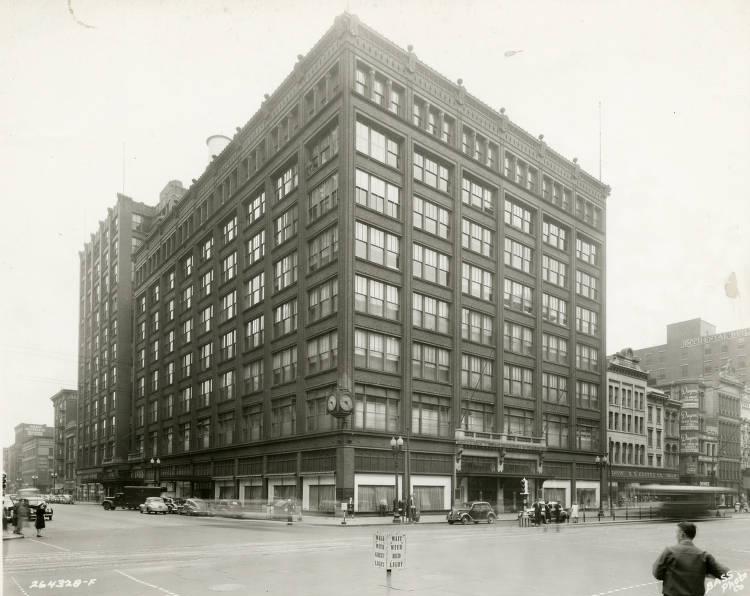
In 1872, bought controlling interest in the Trade Palace, a well-established dry and fancy goods store at 26-28 West Washington Street, operated by N. R. Smith and Company. The partnership name was changed to N. R. Smith and Ayres, with Ayres remaining in New York to serve as the resident buyer for the store.
In 1874, Ayres moved his family to Indianapolis after he bought N. R. Smith’s interest in the store and changed the name to L. S. Ayres & Company. In 1875, Ayres relocated his store across the street to 33-37 West Washington Street in a new three-story building. He had a progressive concern for the welfare of his employees and personable customer service. He also was ahead of his time with the early use of gas, incandescent lighting, and telephones. L. S. Ayres & Company was the first retailer in the city to install elevators and the first in the state to have glass merchandise showcases.
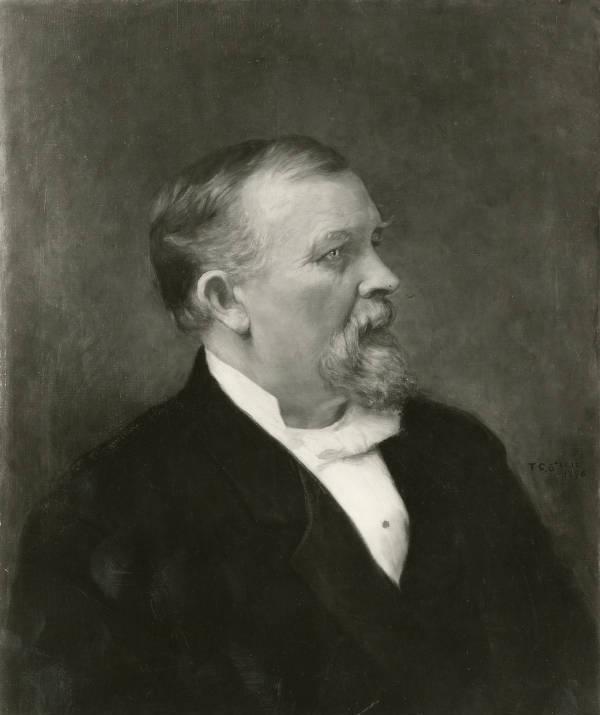
Frederic M. Ayres, Lyman’s son, assumed control of the store upon his father’s death in 1896. Ayres incorporated the store as L. S. Ayres & Company with himself as president and began a period of internal expansion. He built a new eight-story store at 1-15 West Washington Street on land purchased by his father in the heart of the shopping district. Opened on October 2, 1905, Ayres was the first retailer in Indianapolis to use the modern concept of a department store.
The original arrangement of the store began with six departments. Less-expensive dry goods were in the economy basement, which included a soda fountain with 125 varieties of sodas. The main floor sold dry goods such as cravats, collars, combs, underwear, laces, nightshirts, perfume, jewelry, and walking sticks. The second floor contained goods by-the-yard and millinery; the third floor stocked ready-made garments for men, women, and children; and interior decorations occupied the fourth floor. The fifth floor’s elegant Tea Room, with its monogrammed china and seating for 300, soon became a popular meeting place, especially for women. The sixth floor housed up to 180 dressmakers who made ready-to-wear clothing and special orders, while carpenters on the seventh floor manufactured picture frames and cabinets, and served as upholsterers. The receiving and marking room was on the eighth floor.
The store arrangement and size grew and changed over the years. This was due in part to Ayres’ ability to attract and develop talented employees. For example, , the company’s first female executive, arrived at L. S. Ayres in 1909 from Chicago’s exclusive infants’ wear retailer, A. Starr Best, to spearhead the opening of L. S. Ayres’ infants’ and children’s department. By 1917, Krauch expanded the original 500-square-foot space she single-handedly operated to 21,000 square feet and 40 employees.
A store newsletter, originally called , appeared in 1914, and an in-store training program began in the early 1920s. The store provided employee benefits such as vacations, insurance, and Christmas bonuses, which continued even during the .
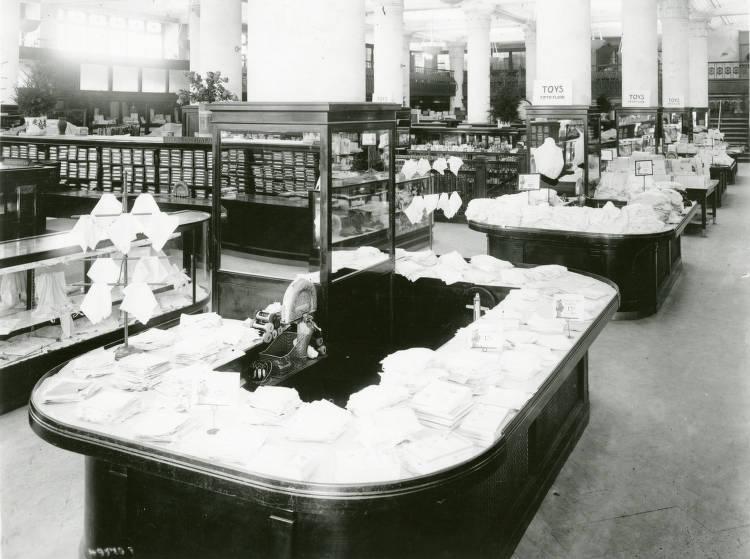
Recognized as a progressive and influential retailer, L. S. Ayres & Company joined nine other leading non-competing national department store retailers in a cooperative information-sharing organization founded in 1916. This organization was the Retail Research Association (RRA). L. S. Ayres & Company already exchanged some business ideas and information with six Midwest stores of comparable size, but membership in the RRA indicated L. S. Ayres’ recognition as a nationally competitive store.
L. S. Ayres gained global reach in March 1918 when the Associated Merchandising Corporation (AMC), an RRA affiliate, organized to buy cooperatively and keep accounting records in a similar manner to share profit and sales information. By 1920 the AMC maintained buying offices in London, Paris, Berlin, Brussels, and Milan. It entered China in 1929.
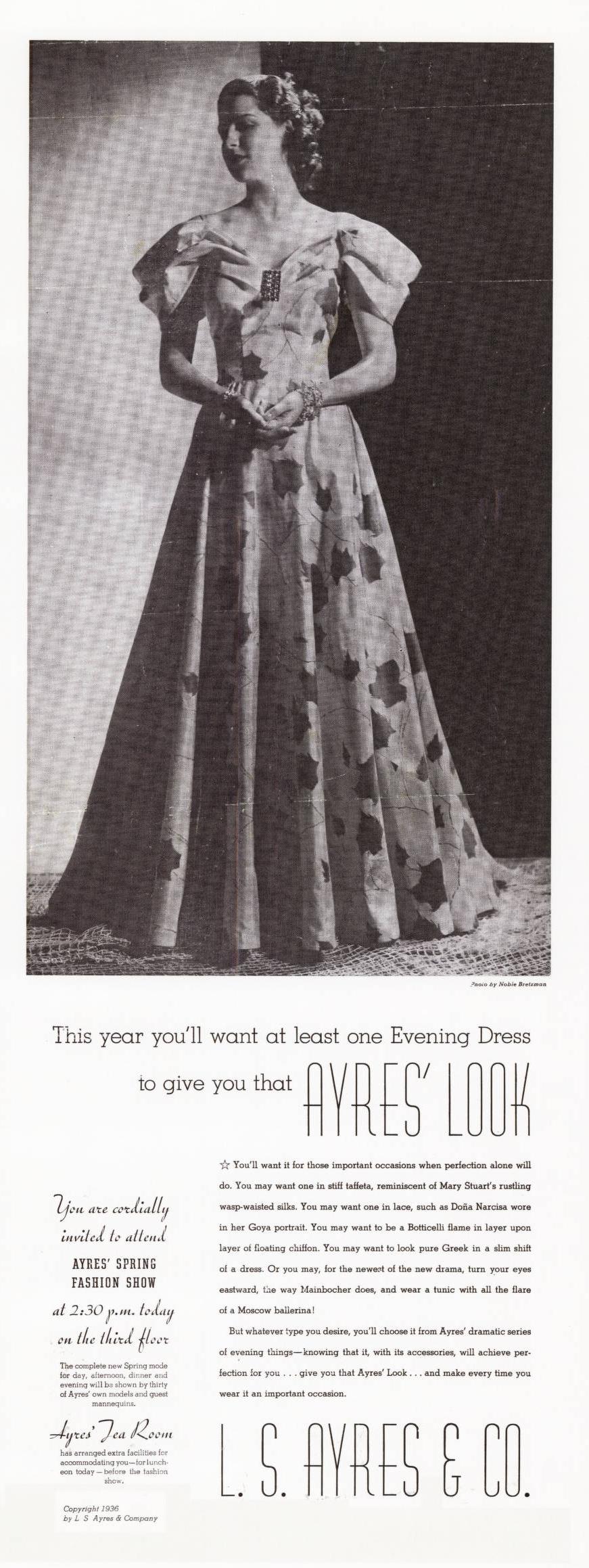
Beginning with its golden anniversary in 1922, the company held annual special events and sales, often emphasizing its connection with the city. “That Ayres Look” was first used on 1936 as an advertising slogan to define Ayres’ philosophy of fashion leadership. The same year the company installed the five-ton electric clock, designed by , on the store’s corner at Washington and Meridian streets. The clock, which could be read at 500 feet, soon became a familiar city landmark. In 1937 Ayres distributed “ChargaPlates” to its charge customers and in 1939 it provided the city’s first “Audichron Service” to give time-of-day by telephone to customers.
Christmas was a special time at Ayres. In 1922 the Ayres Christmas Carollers first sang from the balcony overlooking the main floor during the week of Christmas. In 1926 its traditional five-story Christmas Candle was placed on the North Building fronting Washington Street. On Thanksgiving Eve 1947, a 1,200-pound bronze cherub sculpted by was first placed atop the Ayres’ clock, to be removed every year at midnight on Christmas Eve. Below the clock, the corner show window displayed the L. S. Ayres store in the 1930s, with moving mechanical figures clothed in period costumes. Inside the store’s eighth-floor auditorium, a Santa Claus Express train carried thousands of children annually through a mountain tunnel and around an ice-covered pond scene to deliver them to Santa Claus.

After World War II, L. S. Ayres expanded beyond Indianapolis. The retailer built and bought stores throughout Indiana, Kentucky, Ohio, and Illinois. L. S. Ayres also developed a number of specialty stores. The acquisition of the local store in 1954 introduced fine china, silver, and jewelry to L. S. Ayres’ shoppers. Lyman S. Ayres II became president of the company in 1954 and opened L. S. Ayres’ first suburban store in the new Glendale Mall in 1958. Eventually, 10 more branches were opened in Indiana and in the Indianapolis metropolitan area. In 1961, L. S. Ayres developed Ayr-Way, a chain of discount stores.
In 1972, Associated Dry Goods acquired L. S. Ayres & Company. L. S. Ayres and Ayr-Way became separate subsidiaries. Target bought Ayr-Way in the early 1980s. and the May Company acquired Associated Dry Goods in 1986, which led to the closure of several Ayres stores. Reported losses at the downtown store of $2.2 million in 1988 (about $5.2 million in 2020) coupled with a dispute with the city over the proposed resulted in the flagship store shuttering its doors in January 1992. A 120-year tradition of business in downtown Indianapolis came to an end.
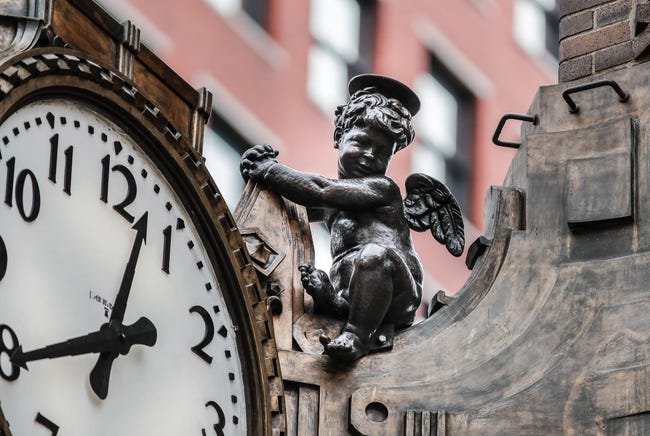
After the closure of the flagship store, the remaining L. S. Ayres stores merged with the May Company’s Famous-Barr division. Federated Department Stores, owner of Macy’s acquired May Company in August 2005. L. S. Ayres & Company dissolved and folded into Macy’s Midwest division in February 2006. By September of that year, the L. S. Ayres moniker was retired when the remaining stores converted to the Macy’s name.
The L. S. Ayres & Company Tea Room can be visited during the winter holiday season at the . The Tea Room re-emerged there in 2000 serving traditional favorites such as chicken velvet soup, Monte Cristo sandwiches, and Hawaiian chicken salad. The famous 10,000-pound L. S. Ayres & Company clock also has been restored to its perch 29 feet above the southwest corner of Washington and Meridian Streets after removal in 2020 to fix leaks and safeguard the bronze case. The mysterious appearance at Thanksgiving of the cherub that sits in the arm of the clock is an annual holiday tradition.

Help improve this entry
Contribute information, offer corrections, suggest images.
You can also recommend new entries related to this topic.